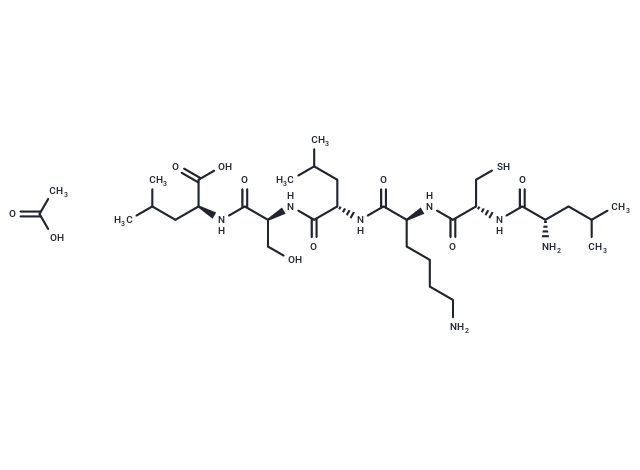Shopping Cart
- Remove All
 Your shopping cart is currently empty
Your shopping cart is currently empty

LCKLSL acetate is a competitive annexin A2 (AnxA2) inhibitor. LCKLSL acetate potently inhibits the binding of tissue plasminogen activator (tPA) to AnxA2 and the generation of plasmin. LCKLSL acetate has anti-angiogenic roles.

| Pack Size | Price | Availability | Quantity |
|---|---|---|---|
| 1 mg | $112 | Backorder | |
| 5 mg | $227 | Backorder | |
| 10 mg | $412 | Backorder | |
| 25 mg | $686 | Backorder | |
| 50 mg | $977 | Backorder | |
| 100 mg | $1,320 | Backorder |
| Description | LCKLSL acetate is a competitive annexin A2 (AnxA2) inhibitor. LCKLSL acetate potently inhibits the binding of tissue plasminogen activator (tPA) to AnxA2 and the generation of plasmin. LCKLSL acetate has anti-angiogenic roles. |
| In vitro | LCKLSL acetate (0-2 mg) inhibits the generation of plasmin and suppresses the VEGF-induced activity of tPA under hypoxic conditions in human retinal microvascular endothelial cells (RMVECs)[1]. |
| In vivo | In chicken chorioallantoic membrane and murine Matrigel plug assays, LCKLSL acetate significantly decreased the vascular length. LCKLSL acetate(5 μg/mL) significantly decreased the number of vascular branches, junctions and end-points[1]. |
| Alias | LCKLSL acetate(533902-29-3 free base) |
| Molecular Weight | 735.93 |
| Formula | C32H61N7O10S |
| Relative Density. | no data available |
| Storage | store at low temperature,keep away from moisture | Powder: -20°C for 3 years | In solvent: -80°C for 1 year | Shipping with blue ice. | ||||||||||||||||||||
| Solubility Information | H2O: 10 mg/mL (13.59 mM), Sonication is recommended. | ||||||||||||||||||||
Solution Preparation Table | |||||||||||||||||||||
H2O
| |||||||||||||||||||||

Copyright © 2015-2025 TargetMol Chemicals Inc. All Rights Reserved.